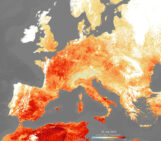The NPG paper of the month for February 2023 was awarded to “A Range of Outcomes: The Combined Effects of Internal Variability and Anthropogenic Forcing on Regional Climate Trends over Europe” by Clara Deser and Adam S. Phillips.
How much will Europe warm in the next 50 years? Will precipitation increase or decrease? Are past climate trends unique or could alternate realities have existed? These questions are at the heart of climate science and challenging to answer. One major reason why they elude simple answers is the fact that internal climate variability (variability that is produced spontaneously in the coupled ocean-atmosphere-land-cryosphere system) co-exists with anthropogenic climate change. To the extent that internal climate variability is largely unpredictable on time scales less than a few years, the precise sequence of internally-generated variability can be thought of as a “roll of the dice”. Such random variability can imprint on trends over finite time intervals even as long as 50 years, lending uncertainty to what past trends might have been and what might be in store for the future, especially at local and regional scales. In analogy to the famous adage “climate is what we expect, weather is what we get”, human-induced climate change is “what we expect” and internal variability plus human-induced climate change is “what we get”. This “certain uncertainty” in regional climate projections introduced by internal variability contrasts with another type of uncertainty due to imperfect representation of physical processes in climate models: the former is irreducible while the latter is potentially reducible as climate models improve. Initial-condition Large Ensembles of simulations with individual Earth System models provide a new perspective on the expected range of past and future climate trends on local and regional scales. Such “Large Ensembles” provide a wealth of information for assessing the risks associated with anthropogenic climate change, including extreme events.
In this paper, we illustrate the plausible “range of outcomes” for past and future 50-year trends in winter temperatures and precipitation over Europe based on a state-of-the-art Large Ensemble with the Community Earth System Model version 2 (CESM2). Using a synthetic Large Ensemble constructed from the statistical properties of 100 years of instrumental data, we demonstrate that the CESM2 simulates realistic magnitudes and patterns of internally-generated climate trends. Finally, we unmask the anthropogenic contribution to observed climate trends by subtracting the component induced by atmospheric dynamics. The estimated thermodynamic trend combined with the synthetic Large Ensemble provides a powerful observational test of the realism of historical simulations from Earth System Models and the plausibility of their future projections.

Alternate Realities. Winter precipitation trends (mm d-1 per decade) over the period 1972-2021 as simulated by the first 28 members of the CESM2 Large Ensemble (number in the lower left of each panel denotes the ensemble member). These trend maps differ solely as a result of unpredictable internal variability, which is superimposed upon a common signal of human-induced climate change (estimated by the ensemble mean trend across all 100 members: panel labeled “EM”). Observed trends are shown in the lower right (panel labeled “OBS”).




